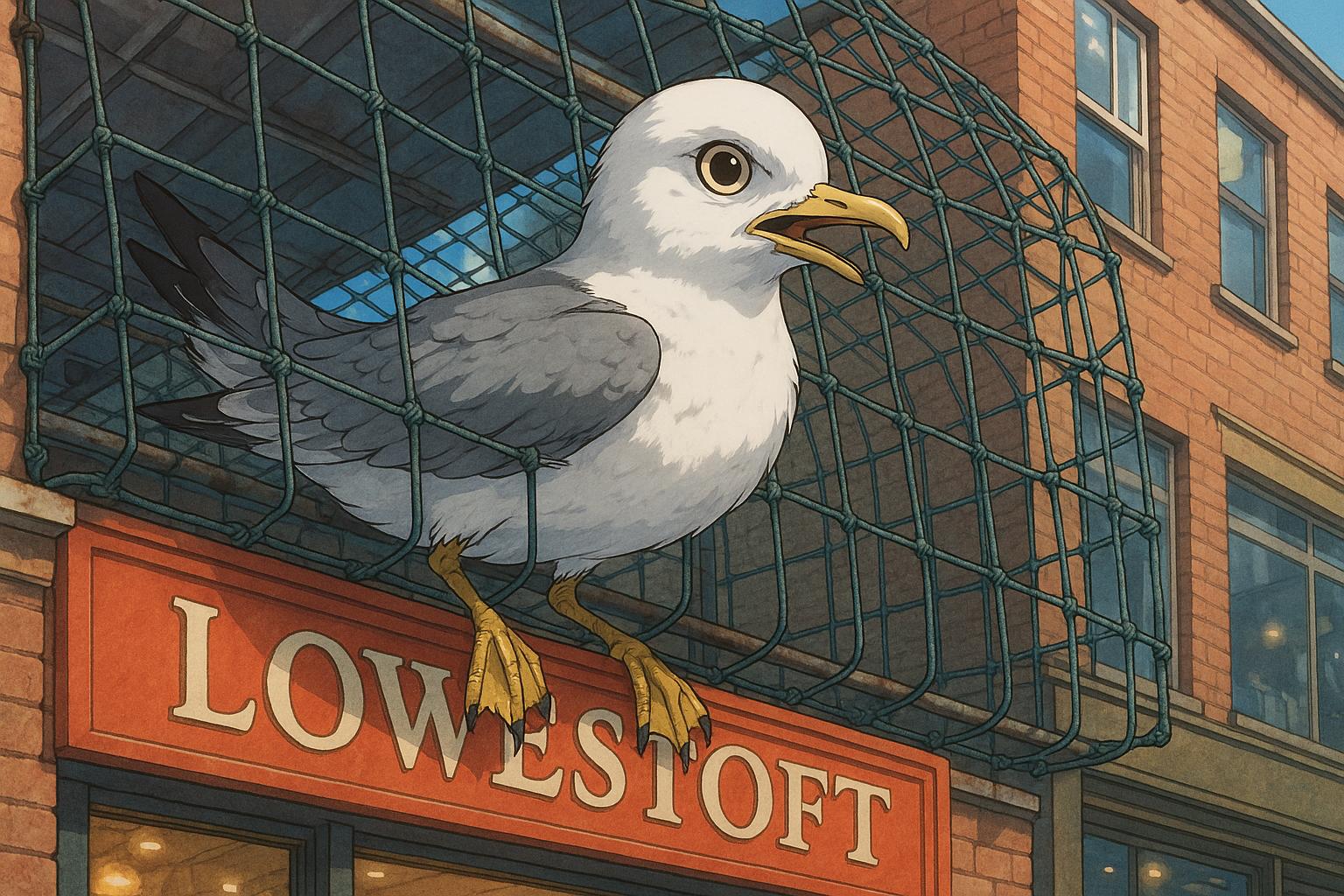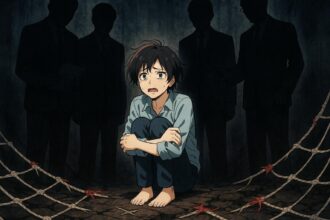As Lowestoft’s kittiwake population grows, a new partnership and offshore nesting structures aim to balance seabird conservation with the needs of local businesses and residents.
Around midday, firefighters were dispatched to V & A Stores on London Road in Lowestoft to assist a kittiwake that had become ensnared in netting over the shop’s entrance. Efforts to free the trapped bird were successful, although it suffered some damage to its feathers in the process. Such incidents underscore increasing interactions between kittiwakes and urban environments, particularly in Lowestoft, which has become home to a burgeoning population of these seabirds.
Kittiwakes are known for their striking appearance and distinctive calls, but they are classified as being on the conservation ‘red list’, indicating that their population is under significant threat. Since the 1970s, numbers of kittiwakes have plummeted by approximately 40%. In recent years, this decline has prompted conservation organisations, like the RSPB, to voice their concerns about protective measures, particularly regarding the use of netting. Firefighters and conservationists alike advocate for better strategies to safeguard these birds, as the netting can obstruct their nesting efforts.
Kittiwakes have made a remarkable comeback in Lowestoft, nesting in a variety of buildings and shops. This resurgence has drawn mixed responses from the local community. While the presence of these birds has become a point of pride, shopkeepers often find themselves spending hours cleaning up the mess left by bird droppings, leading to frustrations over the challenges of cohabitation. The relationship between the community and the kittiwakes is undoubtedly complicated, as many business owners grapple with the duality of their environmental significance and the inconvenience they pose.
In response to the increased nesting, 2023 saw the introduction of offshore “artificial nesting structures” termed the “kittiwake hotels” off South Beach. This initiative, spearheaded by the energy company Ørsted, aims to provide alternative nesting sites for the birds, thereby alleviating some pressure on urban areas. However, it is important to note that these structures are not expected to relocate the existing kittiwake population in Lowestoft, as they tend to return to their established nesting sites each year.
Local stakeholders have recognised the need for a more structured approach to manage kittiwake populations sustainably. The establishment of the Lowestoft Kittiwake Partnership marks a concerted effort involving the Suffolk Wildlife Trust, the RSPB, local councils, and business groups. This partnership aims to provide advice and support to property owners on how to coexist with kittiwakes, ensuring both that the birds can nest safely and that businesses can operate effectively.
Furthermore, community initiatives have emerged to raise awareness about the ecological importance of these seabirds. A recent mural project at Northfield St Nicholas Primary Academy, involving local students, aims to educate young people about the significance of wildlife in their area while celebrating the kittiwake as a familiar yet endangered species.
Navigating the balance of conservation and community interests is challenging, as evidenced by the ongoing discussions at the Lowestoft Town Council. They have taken proactive steps by part-funding a dedicated officer whose role is to reframe the narrative surrounding kittiwakes from pests to valued assets. This shift is crucial in fostering a culture of coexistence that benefits both local wildlife and business interests moving forward.
As Lowestoft continues to grapple with the realities of its vibrant kittiwake population, the town stands at a crossroads, where conservation efforts must harmonise with the needs of a developing urban environment.
Reference Map
- Paragraph 1: (1)
- Paragraph 2: (2), (3)
- Paragraph 3: (1), (2), (3)
- Paragraph 4: (1), (3)
- Paragraph 5: (5), (6)
- Paragraph 6: (4)
- Paragraph 7: (7)
Source: Noah Wire Services
- https://www.edp24.co.uk/news/25174614.fire-crew-called-free-trapped-kittiwake-lowestoft/?ref=rss – Please view link – unable to able to access data
- https://www.bbc.co.uk/news/uk-england-suffolk-57056408 – Firefighters in Lowestoft rescued a kittiwake trapped in netting on a building in Station Square. The RSPB had previously criticized such netting for obstructing endangered birds from nesting. The kittiwake is on the conservation ‘red list’, indicating it requires urgent action. ([bbc.co.uk](https://www.bbc.co.uk/news/uk-england-suffolk-57056408?utm_source=openai))
- https://www.suffolknews.co.uk/lowestoft/rare-bird-rescued-from-building-after-charity-and-tv-present-9198689/ – A kittiwake was rescued from netting on a Lowestoft building by firefighters, following calls from the RSPB and TV presenter Chris Packham for property owners to remove such nets. The RSPB highlighted the global decline of kittiwake numbers by 40% since the 1970s. ([suffolknews.co.uk](https://www.suffolknews.co.uk/lowestoft/rare-bird-rescued-from-building-after-charity-and-tv-present-9198689/?utm_source=openai))
- https://www.suffolkwildlifetrust.org/news/new-nesting-kittiwake-lands-northfield-st-nicholas-primary-academy – A new kittiwake mural was unveiled at Northfield St Nicholas Primary Academy in Lowestoft, funded by Lowestoft Rising and Lowestoft Town Council. The mural, painted by street artist ATM with student involvement, is part of the town’s Wild Mural Trail and aims to raise awareness about local wildlife. ([suffolkwildlifetrust.org](https://www.suffolkwildlifetrust.org/news/new-nesting-kittiwake-lands-northfield-st-nicholas-primary-academy?utm_source=openai))
- https://www.edp24.co.uk/news/20630939.new-partnership-help-safeguard-endangered-kittiwakes-coastal-town/ – The Lowestoft Kittiwake Partnership, comprising various local organizations, was established to protect the endangered kittiwake colony in Lowestoft. The partnership aims to ensure kittiwakes can nest safely while minimizing conflicts with businesses and residents. ([edp24.co.uk](https://www.edp24.co.uk/news/20630939.new-partnership-help-safeguard-endangered-kittiwakes-coastal-town/?utm_source=openai))
- https://www.suffolkwildlifetrust.org/news/lowestoft-kittiwake-partnership – Suffolk Wildlife Trust, along with the RSPB, councils, business groups, community members, and local MP Peter Aldous, formed the Lowestoft Kittiwake Partnership. The partnership provides advice and support to businesses and building owners to help kittiwakes nest safely in Lowestoft. ([suffolkwildlifetrust.org](https://www.suffolkwildlifetrust.org/news/lowestoft-kittiwake-partnership?utm_source=openai))
- https://www.bbc.co.uk/news/uk-england-suffolk-61008854 – Lowestoft Town Council agreed to part-fund the salary of a dedicated officer to help businesses view the endangered kittiwake as an ‘asset not a pest’. The officer’s role is to minimize and mitigate conflicts between the birds and local businesses. ([bbc.co.uk](https://www.bbc.co.uk/news/uk-england-suffolk-61008854?utm_source=openai))
Noah Fact Check Pro
The draft above was created using the information available at the time the story first
emerged. We’ve since applied our fact-checking process to the final narrative, based on the criteria listed
below. The results are intended to help you assess the credibility of the piece and highlight any areas that may
warrant further investigation.
Freshness check
Score:
8
Notes:
The content does not appear to be recycled from older articles. It discusses recent initiatives and ongoing local issues, which suggests it is current.
Quotes check
Score:
0
Notes:
There are no direct quotes in the narrative.
Source reliability
Score:
7
Notes:
The narrative originates from the Eastern Daily Press, which is a reputable local publication, but not as globally recognized as outlets like the BBC or Financial Times.
Plausability check
Score:
9
Notes:
The claims about the kittiwake population and conservation efforts in Lowestoft are plausible and align with known issues and initiatives in the area.
Overall assessment
Verdict (FAIL, OPEN, PASS): PASS
Confidence (LOW, MEDIUM, HIGH): HIGH
Summary:
The narrative appears to be current and plausible, discussing real conservation efforts and local issues. The source is reliable, though not as prominent as major international news outlets.













